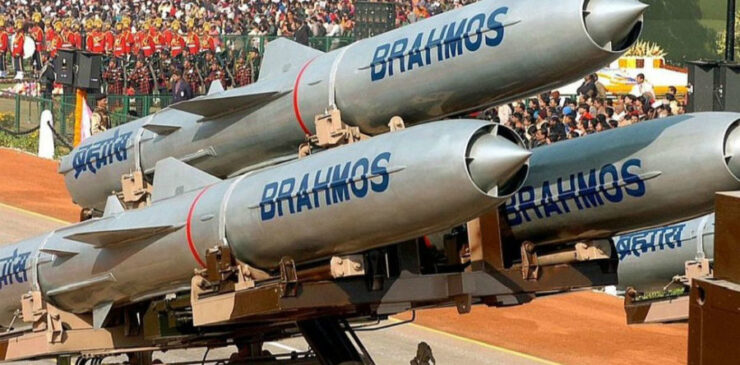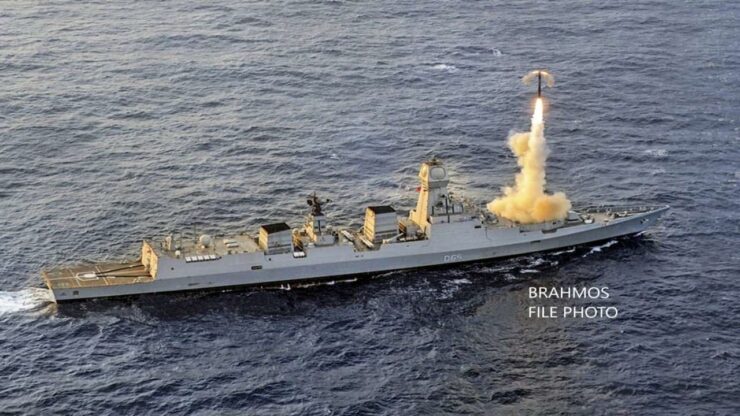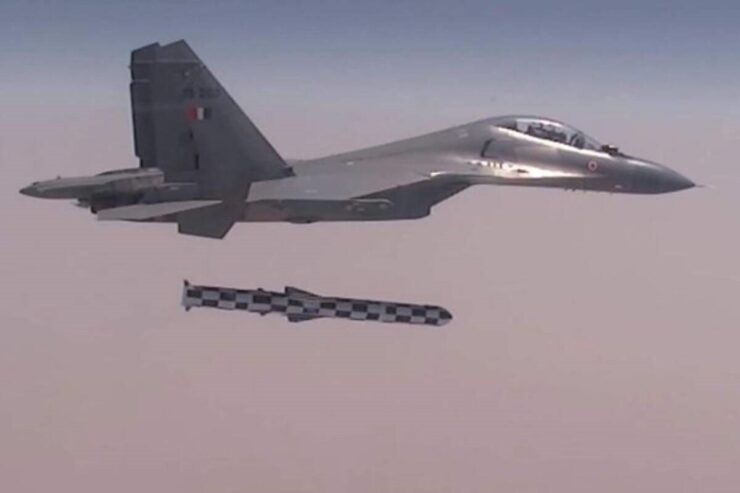
On January 11, 2022, supersonic BRAHMOS NV was test fired from Indian Navy Ship, INS Vishakhapatnam – a stealth guided missile destroyer somewhere in Bay of Bengal and precisely hit the designated target almost 300 kms away within 15 minutes of its launch.Prime Minister and Defence Minister congratulated Indian Navy for its mission readiness and DRDO for yet another stride towards “Mission Atmanirbhar”.
BRAHMOS, under Project 10, produced by India is one of the best cruise missilein the world. It is medium range, supersonic, based on ramjet principle, capableof being launched from trident modes i.e. sea, land and air platforms. BrahMos Aerospace Limited is a joint venture between Defence Research and Development Organisation (DRDO)of India and Mashinostroyenyia (NPO)of Russian Federation. The name BrahMos is a portmanteau, coined from two rivers, Brahmaputra river of India and Moskva river of Russia.
BrahMos Aerospace Limited was established with aim to design, develop, manufacture and market the world’s best supersonic cruise missile on February 12, 1998 as a Joint venture. The MoU was signed between Dr APJ Abdul Kalam, then DRDO Chairman from India and RussianDeputy Defence Minister N V Mikihilov, who was also head of NPO Mashinostroyenyia, a federal state unitary enterprise of Russia.The initial investment for the corporation was $ 250 million shared between India (50.5 %) $ 126.25 million dollars and Russia (49.5%) $ 123.75 million dollars.
The founder CEOand Managing Director of the project was Dr Shivathanu Pillai. The corporate Headquarters was established at New Delhi in 1999 and BrahMos Aerospace integration /production centre at Hyderabad in Telangana in 2001. The second production and testing facility was established at Thiruvananthapuram, Kerala in 2008 by taking over Kerala Hi-Tech Industries Limited. Initially till 2008, Russia supplied 65% of the component including ramjet engine and radar trekker but now India makes 65 % of missile parts in India and 35% parts are provided by Russia. With the BrahMos manufacturing centre coming up in Lucknow Defence Industrial Corridor in 2021, the indigenous component will rise to almost 90% with Indian made seeker and booster engine. Dr Sudhir Kumar Mishra took over as second CEO in 2014. The present CEO, who took over in 2021, is Dr Atul Dinkar Rane.

A cruise missile is a guided missile used against terrestrial or ground targets. The missile generally follows a non-ballistic trajectory at an extremely low altitude. It flies at a constant speed. It is designed to deliver a conventional/nuclear warhead over long distance and with high precision. The older version of cruise missile like Tomahawk of USA had subsonic speed but new versions are capable of cruising at supersonic as well as hypersonic speed. The advantage of cruise missile over ballistic missile is that it does low flying and cannot be detected by radars, electronicsurveillance devices and even AWACs. It has very low circular error probability (CEP), meaning they are very accurate, precise and with low collateral damage. Interception is very difficult. The disadvantages are that it cannot carry large warheadsand generally subsonic, low flying. Moreover, cruise missiles cannot have capabilities of long range like intercontinental ballistic missiles (5000 kms plus). Cruise missiles can be divided into three groups as per speed .The first type are subsonic version likeAGM 86B, AGM 129, BGM Tomahawk (USA), KH 55,65, 101 (Russia), G4 (North Korea), Nirbhay (India), C/D10 (China), Popeye Turbo (Israel), Hoveyzeh (Iran). Supersonic version are 3MS4 Sizzler, 3M51, KH15, P500, 700, 800, 1000 (Soviet), AGM69, Regulus 2 (USA), Moynee Portee Air Sol (France), BRAHMOS B1, B2, B2A (Indo-Russian), C101, 301, 803, 805, CX1, YJ 12, 18, 91 (China). The third and most advanced type of cruise missile is hypersonic version which means missile can fly at five times the speed of sound (Mach 5). These are still in development stage.
India leads the show with BRAHMOS 2 already tested (Indo-Russian). HDTV scramjet (Indian), AGM183, LRHW still under development (USA), KH47M2, KH90, Zircon still not in service (Russia), China Hypersonic carrier is in trial mode only.
BRAHMOS 1 was first test fired on June 12, 2001 from Integrated Test range (ITR), Chandipur in vertical configuration. On June 14, 2004 it was fired from Mobile Launcher. On March 5, 2008, it was launched from INS Rajput and later from INS Ranveer. The BRAHMOS was test fired at Pokhran ranges for summer trials with success. On September 5, 2010, BRAHMOS created a world record for being the first supersonic cruise missile. Submarine launch version was successfully test fired on at NSTL underwater pods on March 20, 2013. BRAHMOS-A version was developed in 2016. Su-30MKI aircrafts were suitably modified and on November 22, 2017, BRAHMOS-A was successfully launched from Su-30MKI and hit the sea based target 500kms away in Bay of Bengal, a record was created by IAF which became the only Air force in world to fire a heavy payload supersonic cruise missile from Fighter Jets. As on date, 40 Su-30MKI have been suitably modified for BRAHMOS fitment. BRAHMOS was tested with indigenous seeker and propulsion system on September 30, 2019 and extended range version was fired in September 2020
BRAHMOS 1 has been developed as a medium range, supersonic cruise missile with state of art features. The basic design is based on acombination of Russian P700 Granit and P800 Oniks cruise missile. BRAHMOS 1 was to have four variants; one,surface launched, second ship launched, third, submarine launched and four, air launchedversion. It had following specifications, length 8.5 metres, diameter 0.5m, weight 2.5 to 3 tons, and warheads conventional/unorthodox of Indian origin.The power plant is two staged, first stage based on solid fuel booster and second stage based on liquid fuel ramjet. Operational range will be 300 kms, to be upgraded to 800 kms in surface/sea version and air launch version range in Su-30MKl will be 500 kms and planned for 1200 kms for extended version. Flight ceiling will be from as low as 10 metres to 50000 feet. The maximumspeed it can cruise is Mach 4.The guidance will be inertial navigation system and active radar homing during terminal phase. The target acquisition will be with help of GPS / Gagan satellite based guidance. Accuracy level achieved will be 1 metre CEP. Production of BRAHMOS l commenced in November 2006 and already three BRAHMOS Regiments are already operational and deployed.
Indian Navy has successfully equipped Rajput class, Kolkata class, Vishakhapatnam class destroyers and Talwar class, Shivalik class, and Nilgiri class frigates with 8 Pods vertical launch system capable of firing BRAHMOS extended naval variant. One squadron of Sukhoi 30MKI has already been modified for air launched variant. Russian air force has also modified its few squadrons of Su-30MS for supersonic BRAHMOS.

BRAHMOS ll will be a hypersonic version of Indian cruise missile. The speed already tested is almost Mach 8,the fastest in the world. Trials are in progress. BRAHMOS ll is likely to be in service by 2024. Yet another version under development is BRAHMOS NG (Next Generation) variant. It will be lighter by half, smart with artificial intelligence, faster Mach 7 to 8 and more lethal and accurate. Additionally, an underwater version is also being developed which will be used by the submarines of India. It will also be offered for export to friendly foreign nations.
Su-30MKI will be able to carry four missiles and also can be fitted on Rafale and Tejas Mk IA and ll.The new production centre spread over 200 acres was inaugurated on December 20, 2021 and will be operational by December 2024.
BrahMos Aerospace has developed an export version with limited range to be supplied to friendly nations. The cost per unit is $ 2.75 million. Countries like Vietnam, Philippines,South Africa,Oman, Chile, Brazil, and Indonesia have shown interest in purchase of BrahMos weapon system. The deal with Vietnam and Philippines is in final stages. Indian government has agreed for line of credit to Vietnam and Philippines. The total export orders expected are worth multibillion dollars.
On January 14, media agency ANI reported that Philippines has accepted BrahMos Aerospace Pvt Ltd’s proposal worth $ 374.9 million to supply Shore-Based Anti-Ship Missile System Acquisition Project for its navy. The Notice of Award has been communicated to BrahMos officials by the Philippines Department of National Defense.
With Philippines acceptance, BRAHMOS has transformed India into a defence hardware exporting nation as it’s largely known as heavy importer country of defence equipment.
-The writer is an Indian Army veteran and a defence analyst. He has keen interest in Geo-strategic affairs and writes regularly on internal and external affairs issues related to India and neighbours. The views expressed are personal and do not necessarily reflect the views of Raksha Anirveda.








